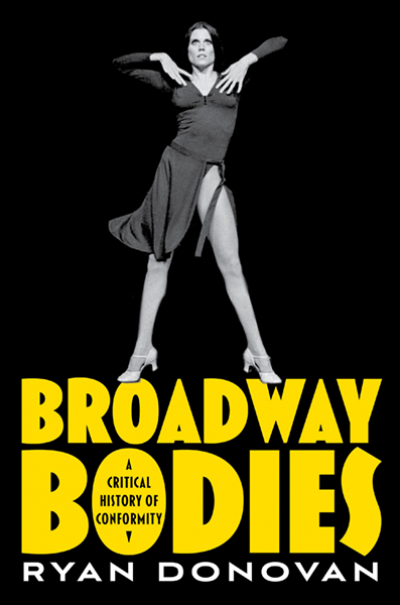Elizabeth Thompson, Trinity Communications

Ryan Donovan’s book, “Broadway Bodies: A Critical History of Conformity,” to be released by Oxford University Press on February 24, is creating a buzz by engaging with the evident.
“What I’ve written about is visible to Broadway audiences, and yet it's also the elephant in the room that nobody talked about for a long time: that casting is inherently a discriminatory process favoring some bodies over others.”
In writing “Broadway Bodies,” Donovan was motivated by “taking the discrimination that people inside the industry know to be true and making it part of the historical record. Who we see on stage — and who we don’t see — matters. Openly acknowledging Broadway’s history of ambivalent inclusion is what I’m interested in introducing into the conversation.”
Donovan, assistant professor of Theater Studies, defines the “Broadway Body” as the “hyper-fit, muscular, tall, conventionally attractive, exceptionally able triple-threat performer (one highly skilled in acting, dancing, and singing)” that became the theater industry’s ideal in the 1970s. Spurred on in part by the success of “A Chorus Line,” which required performers to be skilled in all three areas, performers whose bodies didn’t conform found themselves increasingly left behind. In “Broadway Bodies,” Donovan uses case studies to examine three areas of pervasive discrimination in casting: size, sexuality, and ability.
As “Broadway Bodies” approaches its release date, Donovan shared his thoughts on the theater industry’s history of ambivalence, and how audiences can help make the stage a more inclusive space. This interview has been edited for length and clarity.
What kind of an impact do you hope “Broadway Bodies” will have?
One question I often get is “What do you want to see happen in the industry?”
I was very careful in the introduction of the book to tell readers that I'm not writing a how-to guide and so I don't offer certain prescriptions about what should happen with casting in the future. What I'm really hoping for is that the book contributes to the ongoing conversation about how to make theater more inclusive, and I focus my sights on Broadway as it’s theater's most prominent venue.
What do you mean when you say Broadway is ambivalent towards inclusivity?
Broadway would like to see itself as an inclusive space, but even when a musical appears to be inclusive it often comes with a price tag. For instance, actors who played Tracy Turnblad in “Hairspray” were told both to lose weight and also to eat candy and milkshakes to maintain a certain weight. This all happened at the same time their weight was being actively monitored by the production at regular weigh-ins.
In the book I also chart how “La Cage aux Folles” was originally cast with two straight actors as the gay leading couple. There was a lot of press generated around that fact that two straight actors would take such a career risk in 1983 — a time when immense stigma was directed at gay people. Later, when the show was revived in the early 2000s with two gay actors as the gay couple, the press was entirely silent about that historic fact.
Do you see any signs that Broadway is changing?
I think we can look at the current Broadway season and see that it's becoming more inclusively cast, with shows like A Strange Loop, Kimberly Akimbo, Fat Ham, and & Juliet. We're seeing an exciting shift from what has come before. Two of these shows, “A Strange Loop” and “Fat Ham,” have Black, queer, plus-sized characters as leads, which is really thrilling to see twice in one Broadway season.
I always remind students and readers that Broadway is a slow industry. It takes so many years to develop a musical or play and to get it to Broadway, through various workshops and readings and out of town productions. It's not a fast art form. However, casting is one place that could be nimbler and more responsive. When the writing and production of theater can't always be as fast as scripted TV, for instance, casting is actually one place that can implement more immediate changes.
What can we, as an audience, do to encourage more inclusivity both on stage and behind the scenes?
The role of the audience is to show up and buy tickets to the work that embodies the world you live in offstage, which is populated with people of all walks of life — all abilities, all sizes, all genders and sexualities, all races and ethnicities, all heights, and so forth.
Put your money where your values are. Money talks in theater, and if audiences demonstrate that they’ll show up for inclusively cast productions, producers will listen.
Learn more about Ryan Donovan and his work in the Duke University Department of Theater Studies.
Donovan presents the talk, "'Must Be Heavyset': Casting, Size, and the Body Politics of Broadway Musicals” on February 17 as part of the Franklin Humanities Institute's tgiFHI series. Read about Donovan's research and scholarship on this important topic.
Ryan Donovan discusses “Broadway Bodies” on the podcast Call Time with Katie Birenboim. Read the accompanying feature.
Save 30% when you order “Broadway Bodies” from Oxford University Press using educational discount code AAFLYG6.